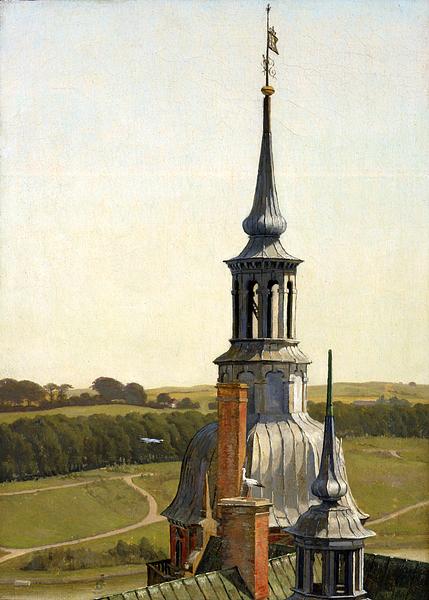Frederiksborg Castle was a favourite subject in Danish Golden Age, constituting a historical monument as well as a symbol of the nation’s proud past. Several painters depicted the castle repeatedly, including Jørgen Roed, P.C. Skovgaard and – especially – Christen Købke, who visited Frederiksborg Castle for the first time in the summer of 1831. He immediately saw its qualities as artistic subject matter, and in the years that followed he would regularly draw and paint scenes from there.
In this small painting, Købke has painted the view from one of the towers of Frederiksborg Castle, showing the copper-clad spires of the castle’s north-east corner tower and the staircase tower in the north-east corner of the main building. From there, the view continues towards the fields and forest on the other side of the castle lake. The wide view out across the landscape creates a vivid impression of both height and distance, and to indicate the scale, Købke has painted a stork on one of the two brick chimneys and another stork in the air above the landscape.
Architectural scenes that provide a clear overview of the entire building were very popular at the time. However, Købke opted for a very different approach because he was among those painters who cultivated a new aesthetic and a new visual idiom.
[1] As in some of his other scenes from Frederiksborg Castle (
31/2014), Købke chose to paint only a small, closely cropped section of the castle and furthermore did so from a surprising point of view, creating an interesting and – for its time – highly modern visual effect. Another eye-catching feature concerns the treatment of forms where different elements, awash in intense sunlight, contrast and harmonise to striking effect.
In 1834–1835, Købke repeated the motif from Frederiksborg Castle as part of the decoration of the dining room in his parents’ house on Blegdammen in Copenhagen.
[2] In that version, which measures no less than 177 x 162 cm, Købke expanded the scene to show more of the roof ridge above the so-called princess wing, creating a different visual impression.
Inv. no. 20/1969
Published in:
Katalog over Malerier og Studier af Christen Schiellerup Købke, udstillede i Kunstforeningen i Foraaret 1884, Kunstforeningen, København 1884, cat. 43, p. 8;
Emil Hannover: Maleren Christen Købke: En Studie i dansk Kunsthistorie, København 1893, p. 71, cat. 61, p. 137;
Raadhusudstillingen af dansk kunst 1901: Fortegnelse over de udstillede Arbejder, København 1901, cat. 1029;
Fortegnelse over Christen Købkes Malerier: Kunstforeningen Marts-April 1912, København 1912, cat. 74;
Mario Krohn: Maleren Christen Købkes Arbejder, København 1915, no. 75, p. 49;
Henrik Bramsen: Christen Købke, København 1942, cat. 16;
Christen Købke: udstilling 31. januar – 28. februar 1953, Kunstforeningen, København 1953, cat. 45;
Erik Zahle (ed.): Danmarks Malerkunst. Fra middelalder til nutid, 4. ed., København 1956, p. 141;
Knud Voss: Guldalderens malerkunst. Dansk arkitekturmaleri 1800-1850, København 1968, pp. 88-92 and fig. 43, p. 87;
Vagn Poulsen: ”Guldalderbilleder” in C.L. Davids Samling. Fjerde del, Jubilæumsskrift 1945-1970, København 1970, p. 24 and no. 5, pp. 30-31;
Dansk kunst og kunsthåndværk, Davids Samling, København 1972, p. 11 og pl. 5;
Vagn Poulsen, Erik Lassen and Jan Danielsen (eds.): Dansk kunsthistorie: billedkunst og skulptur. Vol. 3, Akademiet og guldalderen, 1750-1850, København 1972, p. 343 and fig. 281, p. 346;
Verner Jul Andersen: Dansk kunst og kunsthåndværk, Davids Samling, 2. ed., København 1983, cat. 424 and ill. VII;
Knud Voss: Guldaldermalerene og deres billeder på Statens Museum for Kunst, København 1976, p. 96;
Alfred Kamphausen: Dänemark: ein Führer, München 1980, p. 225;
Kasper Monrad i L’âge d’or de la peinture danoise 1800-1850, Grand Palais, Paris 1984, s. 219, 222;
Kjeld von Folsach: Davids Samling gennem 24 år, 1962-1985 = The David Collection: a 24-year period: 1962-1985, København 1985, pp. 16-17;
Kasper Monrad: “Købke på Frederiksborg i 1835” in Nina Damsgaard (ed.): Danmarks Christian - Chr. IV i eftertiden, Aarhus Kunstmuseum, Århus 1988, cat. 1926, p. 56;
Torsten Gunnarsson: Friluftsmåleri före friluftsmåleriet. Oliestudien i nordiskt landskabsmåleri 1800-1850, Acta Universitatis Upsaliensis, Ars Suetica 12, Uppsala 1989, p. 123;
Kasper Monrad: Hverdagsbilleder: dansk guldalder – kunstnerne og deres vilkår, København 1989, pp. 181 and 134-235 and fig. 168;
Sanford Schwartz: Christen Købke, New York 1992, pp. 35-36 and pl. 34;
Kasper Monrad and Philip Conisbee (et al.): The golden age of Danish Painting, Los Angeles County Museum of Art and Metropolitan Museum of Art, New York 1993, cat. 63, pp. 151-156;
Mark Haworth-Booth: "Et personligt syn på Davids Samling", in Kunst og antikviteter, 3,1995, pp. 8-9;
Hans Edvard Nørregård-Nielsen and Kasper Monrad (eds.): Christen Købke, 1810-1848, Statens Museum for Kunst, København 1996, fig. 116, pp. 185, 187-188, cat. 75;
Poul Erik Tøjner: Museernes bedste billeder, København 1999, 2.ed., p. 196;
Hans Ottomeyer, Klaus Albrecht Schröder and Laurie Winters: Biedermeier: the invention of simplicity, Milwaukee Art Museum, Albertina and Deutsches Historisches Museum, Milwaukee 2006, fig.no. 241, cat. XII-36, pp. 271, 375;
David Jackson and Kasper Monrad: Christen Købke: Danish master of light, National Gallery, London og National Gallery Complex, Edinburgh 2010, pp. 51-54, fig. 33;
Kasper Monrad: Dansk guldalder: lyset, landskabet og hverdagslivet, København 2013, ill. 171, p. 235;
Karina Lykke Grand, Lise Pennington and Anne Mette Thomsen (eds.): Guld: skatte fra den danske guldalder = Gold: treasures from the Danish golden age, ARoS, Aarhus 2013, p. 182 (ill. 21) and p. 189;
